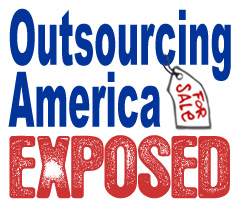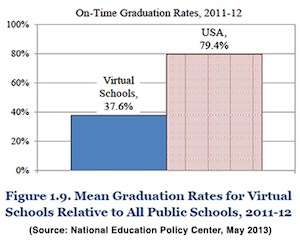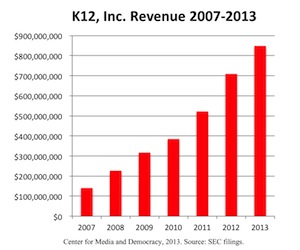From Junk Bonds to Junk Schools: Cyber Schools Fleece Taxpayers for Phantom Students and Failing Grades
 The data is in and K12 Inc.'s brand of full-time public "cyber school" is garbage. Not surprising for an educational model kicked off with a $10 million investment from junk-bond king Michael Milken.
The data is in and K12 Inc.'s brand of full-time public "cyber school" is garbage. Not surprising for an educational model kicked off with a $10 million investment from junk-bond king Michael Milken.
Milken was the Wall Street financier who virtually invented junk-bonds -- high-risk securities that were used to leverage hostile buyouts in the "go-go" 1980s. Milken came to symbolize Wall Street excess, serving as inspiration for the Michael Douglas character Gordon Gekko in the 1987 movie Wall Street. Milken spent almost two years in a federal penitentiary for securities fraud.
After he was released from prison, Milken set his sights on the $600 billion public education "market," forming new companies including Knowledge Universe and Knowledge Learning, parent company of the KinderCare child care chain. With his $10 million stake in K12 Inc., Milken aided one of his Vice Presidents and another junk dealer, Ron Packard, who specialized in mergers and acquisitions for Goldman Sachs back in the '80s.
The duo prepped to exploit the public education sector, and boy, have they. His various educational ventures have made Milken one of the richest men in America, and Packard raked in over $16 million in compensation from 2008 to 2012 as CEO of K12 Inc. Almost all of that money came from U.S. taxpayers.
Explosion of For-Profit "Virtual Schools" Linked to ALEC
In recent years, there has been an explosion of full-time "virtual" charter schools paid for by the taxpayer. From 2008 to 2012, 157 bills passed in 39 states and territories (including the District of Columbia) that expand online schooling or modify existing regulations. Many of these bills are attributable to American Legislative Exchange Council (ALEC) politicians.
ALEC approved a "model" Virtual Public Schools Act in 2005 at a time when both K12 Inc. and Connections Academy (the second largest for-profit) were corporate sponsors and helped craft the measure, according to ALEC's website at the time. Connections Academy quit ALEC under pressure, but K12 Inc. remains on the ALEC Education Task Force and helped sponsor the organization's recent 40th anniversary shindig in Chicago.
K12 Inc. and ALEC have pushed a national agenda to replace brick-and-mortar classrooms and hands-on teaching with computers and "distance learning." K12 Inc. operated 58 full-time virtual schools and enrolled close to 77,000 students in the 2010-2011 school year.
Cyber School Students, Here Today Gone Tomorrow
Like the ubiquitous African email scammers that promise great things as long as you pay them in advance, evidence is building that some full-time charter schools charge state taxpayers big bucks for students who may only spend a few days or a few weeks in front of a computer before they decide that "virtual" education is not for them -- but the schools keep the cash anyway.
Here is the trick. In many states, there is an annual "count date" or dates where heads are counted and state funding is distributed per child. Evidence is mounting that for-profit charters spend a massive amount on advertising to pack in students before the count ("enrollment bursts," one education expert calls it), but once they get the cash, things fall apart.
A 2012 USA Today exposé revealed that "virtual, for-profit K-12 schools have spent millions in taxpayer dollars on advertising" -- $94.4 million from 2007 to 2012. K12 Inc. spent some $21.5 million in just the first eight months of 2012. Worse, K12 Inc. targets kids with huge ad buys on Nickelodeon, The Cartoon Network, as well on teen sites such as MeetMe.com and VampireFreaks.com.
One former teacher from Pennsylvania's Agora Cyber Charter School, which is run by K12 Inc., talked about being assigned 300 students and not having any idea how many attended class: "A huge portion of my students never showed up or did anything. I have no clue what happened to them, though I have no doubt Agora was charging the state for them," she said.
Another former teacher from K12 Inc.'s Colorado Virtual Academy said, "Three-quarters of my credit recovery kids never logged in, never completed any work, never answered their emails or phone calls, yet they remained on my class rosters. I began wondering about the state-mandated hours for students at the high school level. No one is monitoring this as far as I can see."
In a few states, regulators are starting to catch on. According to the New York Times, a Colorado state audit found that K12 Inc.'s Colorado Virtual Academy received money for 120 students whose enrollment could not be verified. The state ordered the school to reimburse $800,000 dollars.
"The kids enroll, you get the money, the kids disappear," says Gary Miron of the National Education Policy Center (NEPC) and Western Michigan University told the Times.
Costs for online learning are much lower than traditional schools. Kids take lessons at home, so the virtual school operators have no classrooms to maintain or heating bills to pay. Teachers are paid less, and student-teacher ratios are massive. But some states pay cyber schools almost as much per child as brick-and-mortar schools -- that's $10,000 per student in Pennsylvania, double what it actually costs, says the state auditor.
The Data Is In: Kids Don't Learn Well in Front of Computer Screens
So while the public school system is bleeding money to cyber schools, how are those cyber students doing?
Until recently, data on performance of these full-time virtual charters has been scarce. But educators at NEPC started to pull together performance data from multiple states for annual and special reports. They confirmed what many suspected: with rare exceptions, kids don't learn sitting in front of a computer all day.
 Using Adequate Yearly Progress (AYP) state data, state performance rankings, and graduation rates, the researchers showed that full-time virtual schools lag significantly behind traditional brick-and-mortar schools. In particular, only 27.7 percent of K12 Inc. online schools met AYP in 2010-2011, compared to 52 percent of public schools. Of the 36 K12 Inc. schools that were assigned a school rating by state education authorities, only seven (19.4 percent) had ratings that clearly indicated satisfactory status.
Using Adequate Yearly Progress (AYP) state data, state performance rankings, and graduation rates, the researchers showed that full-time virtual schools lag significantly behind traditional brick-and-mortar schools. In particular, only 27.7 percent of K12 Inc. online schools met AYP in 2010-2011, compared to 52 percent of public schools. Of the 36 K12 Inc. schools that were assigned a school rating by state education authorities, only seven (19.4 percent) had ratings that clearly indicated satisfactory status.
The same study shows that on-time graduation rates are also much lower at online schools than at all public schools on average in the United States: only 37.6 percent of students at virtual high schools graduate on time, whereas the national average for all public high schools is more than double that: 79.4 percent.
"The evidence is clear that kids are not doing as well in virtual schools as kids in charter schools or public schools," says Luis Huerta of NEPC and Teachers College-Columbia University.
Of particular concern to critics is the company's emphasis on serving high-risk students who don't have the motivated homeschool parents and support structures needed to make the most of the model. Why would K12 Inc. focus on this population? "It was an explicit business strategy to go after kids who would demand the least from their educational experience, which ultimately yields increased profits for K12 Inc.," explains Huerta.
Irate Investors and Unhappy School Districts
In 2012, K12 Inc.'s cyber model came under fire from a surprising source: the company's shareholders. They took a look at the emerging data and filed a class action suit alleging that Packard violated securities law by making false statements and omissions to investors about student performance. Another key allegation in the lawsuit was that K12 Inc. schools were hiding dropout rates or "churn" rates of more than 50 percent. This critical factor was "obscured by K12's aggressive tactics to replace those who dropped out, allowing K12 to maintain the illusion that overall enrollments were increasing." The parties reached a tentative settlement for $6.75 million in March 2013, and company officials continue to deny any wrongdoing.
Affidavits from former K12 Inc. teachers that were incorporated into the complaint paint a devastating picture of an enrollment-driven, profit-driven corporate culture that leaves kids in the dust. (Note to Wall Street: If you want to exploit children, don't hire a bunch of teachers who actually care about kids.)
 Here in Wisconsin, where the school choice movement began and where there has been a rapid expansion of distance learning, two Wisconsin school districts with online education programs -- Grantsburg's iForward and Waukesha's eAchieve Academy -- announced that they would not renew their contracts with K12 Inc. for the 2012-2013 school year.
Here in Wisconsin, where the school choice movement began and where there has been a rapid expansion of distance learning, two Wisconsin school districts with online education programs -- Grantsburg's iForward and Waukesha's eAchieve Academy -- announced that they would not renew their contracts with K12 Inc. for the 2012-2013 school year.
Grantsburg School District Superintendent Joni Burgin told the Center for Media and Democracy (CMD) that when the contract was purchased by K12 Inc., it was "fraught with challenges from the get-go. By the end of the year, we decided we couldn't do it anymore. We decided to manage the school on our own." Although the move to take the school's management in-house was challenging at first, Burgin said, now they "don't have to sit at a table and arm-wrestle with corporate business people who don't understand how education is done in Wisconsin and don't always have the students' interests in mind. It's called 'for-profit' for a reason."
The Big Short: Wall Street Turns on K12 Inc.
For K12 Inc. CEO Ron Packard, it's all about "educational liberty." "Kids have been shackled to their brick-and-mortar school down the block for too long," he puffs.
Packard himself is "shackled" to the big bucks. In 2013, K12 Inc. took in $848.2 million from its business, with $730.8 million coming from its "managed public schools" (a.k.a. the taxpayers). That kind of money could buy you an army of actual teachers, more than 13,000 using Wisconsin teacher salaries as a guide.
 Although his firm was born on Wall Street, some on Wall Street have turned against Packard's model. Hedge fund manager Whitney Tilson recently announced he was shorting K12 Inc. stock, effectively betting that the company would fail. His 125-page slide show explaining his reasoning is a compelling indictment of the model. He points out that Milken's Knowledge Universe group recently distributed its shares in K12 Inc. to investors, a predicate to cashing out.
Although his firm was born on Wall Street, some on Wall Street have turned against Packard's model. Hedge fund manager Whitney Tilson recently announced he was shorting K12 Inc. stock, effectively betting that the company would fail. His 125-page slide show explaining his reasoning is a compelling indictment of the model. He points out that Milken's Knowledge Universe group recently distributed its shares in K12 Inc. to investors, a predicate to cashing out.
"Like subprime lenders giving mortgages to people with bad credit, this can be a good and socially beneficial business when it is carefully targeted. But when you introduce unlimited government money and virtually no government regulation, the industry will run amok," Tilson told CMD. He argues that the K12 Inc. model is not appropriate for mass consumption, pointing to huge enrollment in Pennsylvania and Ohio K12 Inc. schools.
But working to maintain the model is an army of lobbyists and ALEC politicians. K12 Inc. has hired 153 lobbyists in 28 states from 2003 to 2012 according to the National Institute on Money in State Politics.
All this leaves education specialists worried. There is no doubt that online education exhibits dazzling possibilities. Education expert Gary Miron uses an extensive suite of online tools to teach college and graduate students, and he is "excited" about the future of online education.
But Miron "doesn't want to see that future defined by corporate interests like K12 Inc. with a very narrow agenda," he told CMD. Miron worries that "before policymakers wake up, we will have spent millions and millions of taxpayer dollars funding a failed education model."
In September, CMD launched a new project on the privatizers and profiteers selling out our democracy. You can find detailed corporate profiles of K12 Inc. and Connections Academy (owned by Pearson, a British multinational media company) on our new website OutsourcingAmericaExposed.org.
Rebekah Wilce and Katie Lorenze contributed to this article.





Comments
NEPC Study
The NEPC conclusion is too simplistic. Is learning from a computer flawed or is the student flawed? Students who lack the ability and initiative to learn independently should probably not be learning from a computer, yet they are allowed to anyway. That sounds like the real problem. Students need to be screened as to whether or not they are qualified to learn independently, with those who don’t qualify sent to a traditional school. The last paragraph in that section of the article seems to confirm this issue. “Of particular concern to critics is the company's emphasis on serving high-risk students who don't have the motivated homeschool parents and support structures needed to make the most of the model. Why would K12 Inc. focus on this population? "It was an explicit business strategy to go after kids who would demand the least from their educational experience, which ultimately yields increased profits for K12 Inc.," explains Huerta.” When you put mediocre, unmotivated students in front of a computer and then blame the computer for their poor results, you have a flawed interpretation of the situation. What this really tells us is that learning should be customized for students and not a one-size-fits-all environment. Let the independent achievers with initiative learn from a computer, if that’s their choice, but put the rest of the students in a traditional classroom.
Success for my child in K12
My son is in an on-line K12 high-school and we find it to be a great fit for his personality. He attends two activities at his local high-school, and enjoys being able to focus on academics at home and socializing during electives once school work is done. I think a lot of kids in these programs have learning disabilities so I don't feel the statistics showing kids in these programs perform below public-school kids is fair. I don't like to see tax dollars funding such high salaries of course, but hope there's continued respect for a variety of school choices.
K12 curriculum
Thank you for this important report. I observed K12 from a different angle, taking a close look at the history curriculum for kindergarten, first, and second grades. The results are sometimes hilarious but mostly distressing. Their professional advice when a parent reported that the child didn't understand a lesson was "Do it again."
"The K12 Virtual Primary School History Curriculum: A Participant’s-eye View":
http://nepc.colorado.edu/files/EPSL-0404-117-EPRU.pdf
Surprising? NO. How could
Surprising? NO. How could anyone think that any for-profit corporation could possibly be interested in anything other than MAKING PROFITS? People who think these cyber schools and charter schools are a great idea worry me. I know the public school system is in the toilet, and the federal gov't. is incompetent and cumbersome, but if you think a for-profit corp. has your child's best interest and education at heart more than the gov't., your delusional.
Public School System
"I know the public school system is in the toilet..." suggests that you have been bludgeoned into believing the so-called school reform talk that our public schools are in shambles, so privatization is the way to improve them. Nothing could be further from the truth. When we disaggregate the testing data demographically, our high performing students do as well as the vaunted European countries. For evidence that our schools are not as bad as the media, the pols, and privatizers claim refer to the recent book by Dr. Diane Ravitch, Reign of Error.
I have my child's best
I have my child's best interest at heart and we learn together with the online school. It causes great discussions at length about many different topics. I KNOW she is learning.
K12 students
Our kids use the k12 curriculum as part of the Hawaii Technology Academy, a state charter school. We have been quite pleased with it. The schoolwork is challenging and engaging, our kids are learning to take responsibility for their own education, and, as parents, we have a much more detailed understanding of what they are learning.
Although online learning is far from perfect, it can be a fantastic opportunity for many students. Brick and Mortar schools are probably better for more children, but they also have a lot of work to do to better prepare them for their future.
Thanks to the parents who
Thanks to the parents who commented on their positive experiences with online courses. There is no doubt that online learning can work well for certain kids with motivated and competent parents, but when it is taken to a mass marketing level for children of all different ages, abilities and home situations that idea starts to fall apart.
ANON. Comments SHOULD be Deprecated
I'd encourage serious commenters on this (or any) subject to use a name other than 'Anonymous' to tag their remarks.
Anonymous commenters in online forums are all too easy to dismiss, as hiding behind their anonymity, so they can say any foolish thing without a tag for 'taking to task' or serious discussion.
If you've got something to say in all seriousness, put a name on it! *Please!* Whether the rest of us agree or disagree, we can make the beginning of a conversation.
That said, I've found that online courses I've attempted (long past secondary level) have been problematic for me. Perhaps it's time pressures, or family demands (two of three daughters, adults, still at home, plus wife) but it can be quite difficult to complete a segment in reasonable time.
Government is not the problem; honesty and real education is the problem, and government CAN be part of the solution. Many things have been tried in classrooms (and out) over many years; somewhere, there must be results-oriented data on this, without the hype and salesmanship these flacks bring to the table. If your schools didn't educate you, AND you didn't learn on your own, you will be MUCH easier to sell these snake-oil 'solutions'.